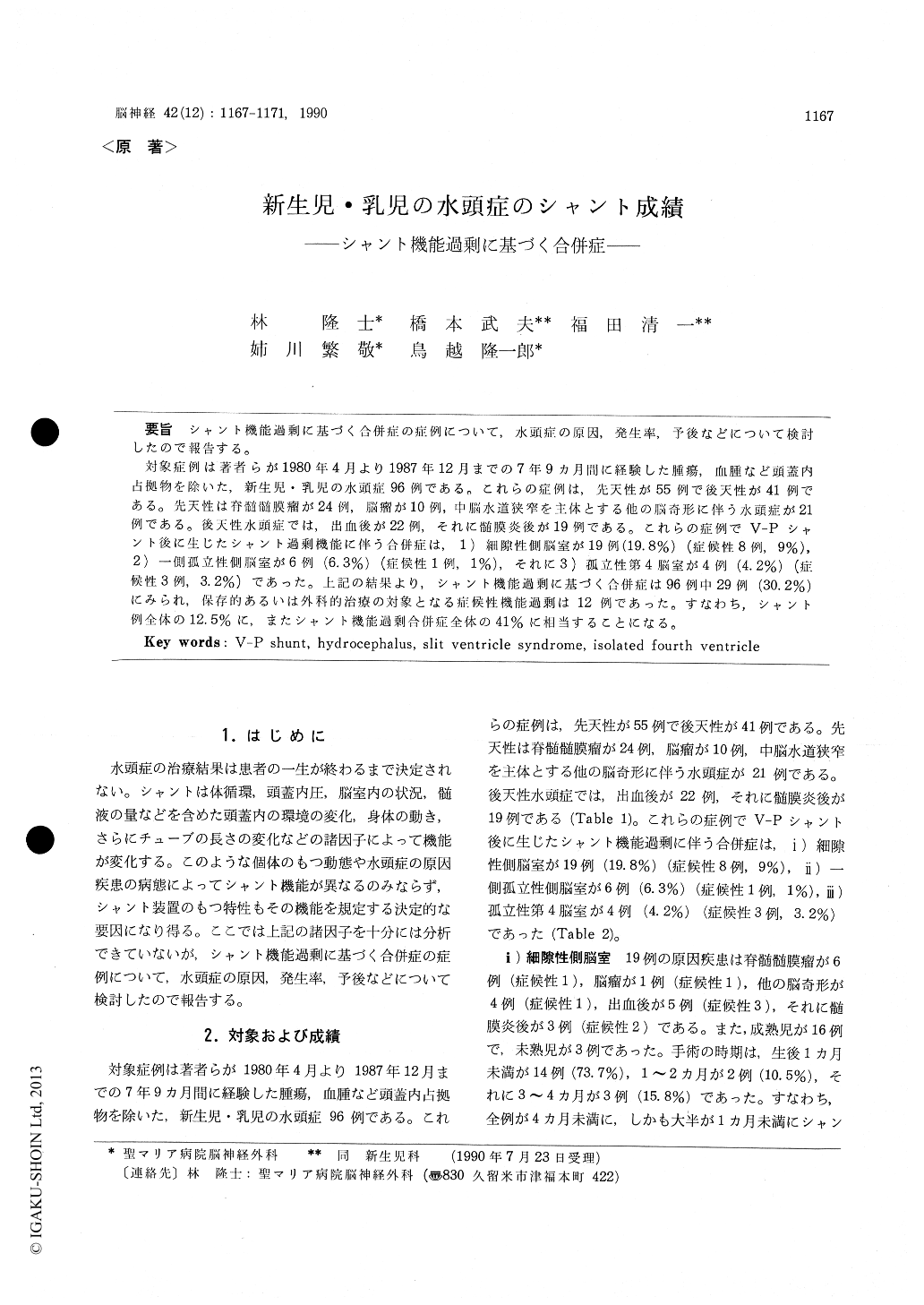Japanese
English
- 有料閲覧
- Abstract 文献概要
- 1ページ目 Look Inside
シャント機能過剰に基づく合併症の症例について,水頭症の原因,発生率,予後などについて検討したので報告する。
対象症例は著者らが1980年4月より1987年12月までの7年9カ月間に経験した腫瘍,血腫など頭蓋内占拠物を除いた,新生児・乳児の水頭症96例である。これらの症例は,先天性が55例で後天性が41例である。先天性は脊髄髄膜瘤が24例,脳瘤が10例,中脳水道狭窄を主体とする他の脳奇形に伴う水頭症が21例である。後天性水頭症では,出血後が22例,それに髄膜炎後が19例である。これらの症例でV-Pシャント後に生じたシャント過剰機能に伴う合併症は,1)細隙性側脳室が19例(19.8%)(症候性8例,9%),2)一側孤立性側脳室が6例(6.3%)(症候性1例,1%),それに3)孤立性第4脳室が4例(4.2%)(症候性3例,3.2%)であった。上記の結果より,シャント機能過剰に基づく合併症は96例中29例(30.2%)にみられ,保存的あるいは外科的治療の対象となる症候性機能過剰は12例であった。すなわち,シャント例全体の12.5%に,またシャント機能過剰合併症全体の41%に相当することになる。
During the past 3 decades hydrocephalus has been treated effectively with valve-regulated shunts and it would appear at present that this means of treatment will continue despite the fact that it probably has a higher complications rate than any other neurosurgical operation. The com-plications are generally categolized as those dueto obstruction, those caused by infection, and those related to overdranage. It appears, however, that the complications due to overdranage such as the slit ventricle syndrome, the isolated unilateral lateral ventricle, and the isolated fourth ventricle and are poorly defined and understood and, there-fore, the treatment has been subject of confusing literature. In this paper, the characteristics of neonatal and infantile hydrocephalus were discus-sed in an analysis of postoperative complications of cerebro-spinal fluid shunt procedures which focuses on the overdranage by the shunt system.
Ninety six cases of hydrocephalus which in-cluded 55 congenital and 41 acquired, were trea-ted during a period of 7 years and 9 months. Patients with congenital hydrocephalus included 24 with myelomeningocele, 10 with encephalocele, and 21 with aqueductal stenosis associated with various cerebral anomalies. Patients with acquired hydrocephalus included 22 with posthemorrhagic and 19 with postmeningitic.
There were 29 cases (30. 2%) in which various complications due to overdranage developed. In 12 of these additional conservative treatment and/ or additional surgical therapies were necessary. Patients with complications included 19(19.8%) with the slit ventricle, 6 with the unilateral isola-ted lateral ventricle, and 4 with the isolated fourth ventricle. These results indicate that 12. 5% of shunted infants and 41% of infants with evidence of overdranage needed some from of additional treatment.
Those overdranaging conditions are thought to result from high intracranial complience due to the softer brain and more markedly widened cranial sutures of infantile hydrocephalus in the younger age group. The functional period of the initial shunt was also much shorter in younger infants, and this may be because the ventricular shrinkage to a slit can cause shunt malfunction with or without developing the slit ventricle syndrome.

Copyright © 1990, Igaku-Shoin Ltd. All rights reserved.


